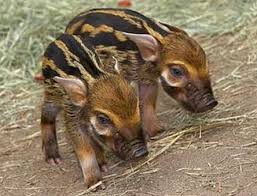- Pigs are intelligent animals.
- Like humans, pigs are omnivores, meaning they eat both plants and other animals.
- A pig’s snout is an important tool for finding food in the ground and sensing the world around them.
- Pigs have an excellent sense of smell.
- There are around 2 billion pigs in the world.
- Humans farm pigs for meat such as pork, bacon and ham.
- Some people like to keep pigs as pets.
- Wild pigs (boar) are often hunted in the wild.
- In some areas of the world, wild boars are the main source of food for tigers.
- Feral pigs that have been introduced into new areas can be a threat to the local ecosystem.
- Pigs can pass on a variety of diseases to humans.
- Relative to their body size, pigs have small lungs.
The words pig, hog and swine are all generic terms without regard to gender, size or breed. A male pig is called a boar. A female pig is called a gilt if she hasn't had piglets yet and a sow if she has.Pigs originated from Eurasian Wild boars.
Pigs are very intelligent and learn quickly. They pick up tricks faster than dogs. Pigs rank #4 in animal intelligence behind chimpanzees, dolphins and elephants. Piglets learn their names by two to three weeks of age and respond when called.
Pigs are very social animals. They form close bonds with each other and other species. Pigs enjoy close contact and will lie close together when resting. Pigs use their grunts to communicate with each other.A sow can give birth to a litter containing 7 to 12 piglets, about twice a year. The gestation period of a sow is 114 days (3 months, 3 weeks and 3 days).
A baby pig, or piglet, weighs about 1.5 kilograms at birth and will double its weight in just 7 days.
Weaning occurs at three months of age, but young pigs continue to live with their mothers. Two or more sows usually join together in an extended family.
Pigs are very clean animals. They keep their toilets far from their living or eating area. Even piglets only a few hours old will leave the nest to relieve themselves. |
Domestic pigs are rarely aggressive. The only exceptions are sows with a young litter and boars if provoked.Pigs are much more tolerant of cold than heat. Pigs have no sweat glands, so they can't sweat. They roll around in the mud to cool their skin. The layer of dried mud protects their skin from the sun. If available, pigs, who are great swimmers, prefer water to mud.
Some pigs have straight and some have curly tailsPigs have a great sense of smell. Their powerful but sensitive snout is a highly developed sense organ. Pigs also have a great field of vision, because their eyes are on the sides of their heads.
Pigs have four toes on each hoof, but only walk on two toes per foot.
A mature pig has 44 teeth.
A pig can run a 7 minute mile..
 |
| baby tapirs |
 Fossils of tapir ancestors have been found on every continent except Antarctica. Tapirs even lived in Southern California about 10,000 years ago. Fossils of tapir ancestors have been found on every continent except Antarctica. Tapirs even lived in Southern California about 10,000 years ago.
April, a Baird's tapir, is the National Animal of Belize. Also known as "the mountain cow," she lives at the Belize Zoo and her birthday is a national event.
In Indonesia, the word “badak” refers to both rhinos and tapirs.
In Thailand, “P'som-sett” is the name for tapir and it means "mixture is finished." This refers to the belief that the tapir was created from leftover parts of other animals.
The word tapir, translated from a Brazilian Indian language, means "thick," referring to the animal's tough hide.
Tapirs create trodden paths through the forest, often leading to reliable water sources. Human engineers sometimes exploit these paths to build roads.
- See more at: http://animals.sandiegozoo.org/animals/tapir#sthash.3Hyz7Ulk.dpuf |
|



























 which animal pic do you think is the cutest!
which animal pic do you think is the cutest!


























 which animal pic do you think is the cutest!
which animal pic do you think is the cutest!























